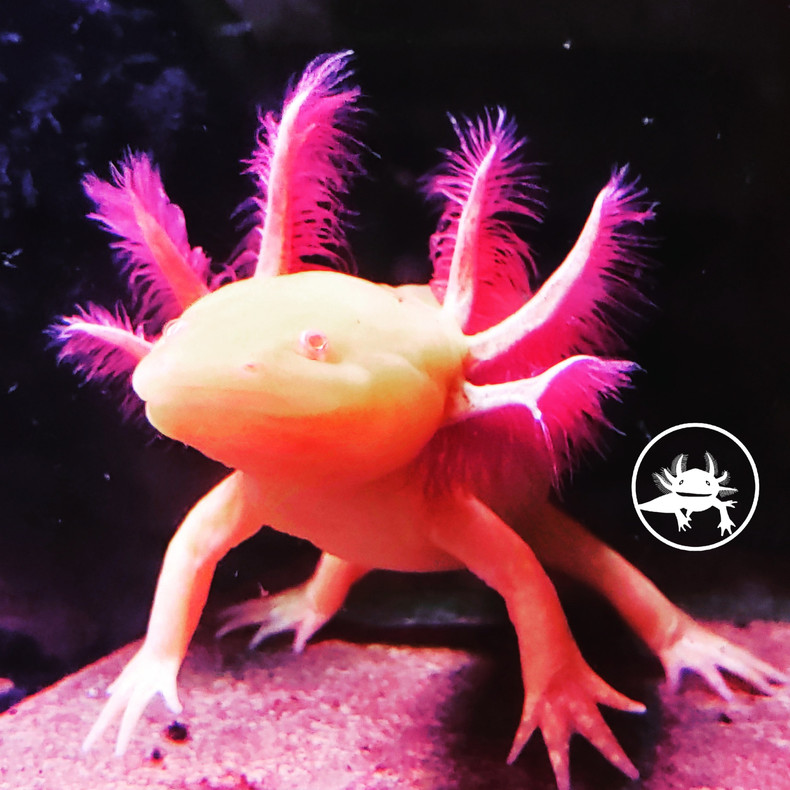* No gravel * Cold water * 20 gal aquarium * Species only * Adults average 9”-12” long *
- 20 gallons for 1 full sized adult axolotl (roughly 9-12 inches) and 10 additional gallons for each additional adult at minimum. Be sure to have proper filtration for the amount of axolotls (which is double or more per gallons). Smaller axolotls can fit in a smaller tank but better to start them at the tank size they will need as an adult.
- Cycling your tank is crucial to the health of your axolotls. That means a good bacteria build up for the bio-load of an Axolotl which is equal to 4.0ppm ammonia. I offer products to help speed this along about 75% faster. Be sure before you place your axolotl into its new home the aquarium is completely cycled. There are different ways you can do this, but before your axolotl goes into its new home this must be done. Until it is cycled you can keep them in a small tub (shoebox size) for a temporary time until the tank is cycled. You must do daily 100% water changes with dechlorinated water to your tub.
- The tub should be used as temporary housing while you cycle the permanent home for your new friend. Seasoned Media filters are seeded filter media that can speed the cycling of your tank by about 75%. We have these available on our website. I also offer seasoned sponge filters as well. Also, an API master test kit (test strips of any kind are not accurate) should still (and always) be used to monitor water conditions. I sell all the products needed for cycling your tank, like all the Seachem products and Dr. Tims Ammonia. I also have detailed instructions on how to cycle your new aquariums.
- Male and female axolotls should not be housed together without a divider. This can cause over breeding, over breeding can shorten the lifespan of the female because it takes all her energy to lay eggs. Females should not be bred more than 1-2 times a year and no earlier than 18 months. Sexual maturity occurs between 8-18 months of age. Males should not be bred until they are at least a year old.
- Dechlorinated water that is 60-68 degrees Fahrenheit and a cycled aquarium is required.
- Sometimes an axolotl needs to be tubbed for either health reasons or for tank cleaning. Be sure when tubbing your axolotl you keep them in clean dechlorinated water. The water has to be changed daily, if you have to keep tubbed for more than a day for health issues. Be sure the tub is big enough for them to move around & filled enough so they can be completely under water. You can also add some fake plants and hides inside of the tub as well.
- Axolotls should not have anything in their tank that is 2x the size of their head or smaller (gravel, rocks, snails, fish, décor etc.) except sand once the axolotl is 5”+ long. Axolotls smaller than 5” should be kept on bare bottom glass, tile, or other substrate than cannot be eaten.
- The only other animals that can be
kept with them are feeder guppies and ghost shrimp both of which they will eat
but do not pose any danger or threat to the axolotl. If more than one axolotl
is in one tank be sure to keep them well fed.
- Treats are okay but the only things that are good for a regular balanced diet are earthworms, carnivore pellets that do not contain land animals or an abundance of plant material, or Repashy. We sell all recommended food.
- Axolotls do not like bright light and should have somewhere to hide to escape the light.
- A low flow filter is best, too much water movement causes stress. We recommend either a sponge or air driven internal corner filter.
- Indian almond leaves release tannins that prevent disease and generally create a better axolotl environment.
- Warm or bad quality water can cause gills to curl forward (more than the normal if they are large heavy gills), fungus, ammonia burn, and other conditions or disease.
- One solution to the ph balance to your tank is a Holtfreters solution. This also helps keep down fungus and helps the axolotl’s immune systems. Axolotls are a fresh water amphibian adding these salts does not change the water from fresh water to salt water. The amount of salt is small in comparison.
- Here is the recipe. You need 3 different types of salt. Non-Iodized table salt, Epsom salt (no scents or dyes) and NuSalt (a salt replacer found near Morton salt. Its Potassium Chloride)Per 5 gallons of dechlorinated water mix- 3 tbs Non-Iodized table salt, 1 tsp Epsom Salt, and 1/8 tsp NuSalt
- Axolotls can live a long healthy life
if well cared for and water conditions are right. The average life span is
10-15 years. I have heard of some living up to 20 years. Feel free to contact me with any issues you
may have. I love to help people enjoy and properly care for Axolotls. Let me know if I can help you in any way.
- Above all please enjoy your new exotic aquatic creature. They are a very special creature!
~
Tina ~
The Mottled Lotl - "Your Source for Everything Axolotl"
Tina Heckman - Owner/Chief Axolotl Fanatic
(440)-289-1671 Call or Text - Email: themottledlotl@gmail.com
Facebook:
http://www.facebook.com/TheMottledLotl

